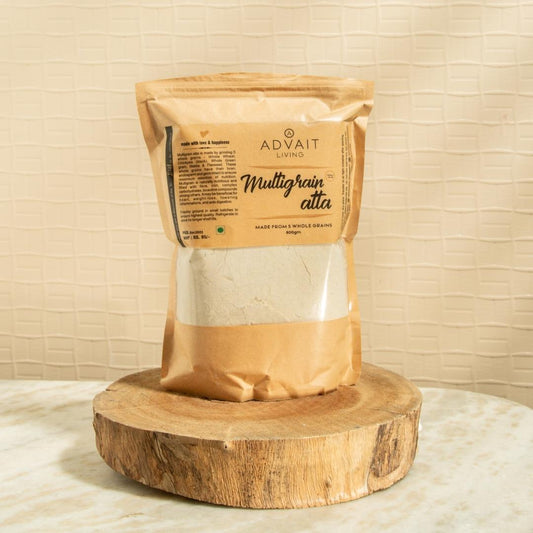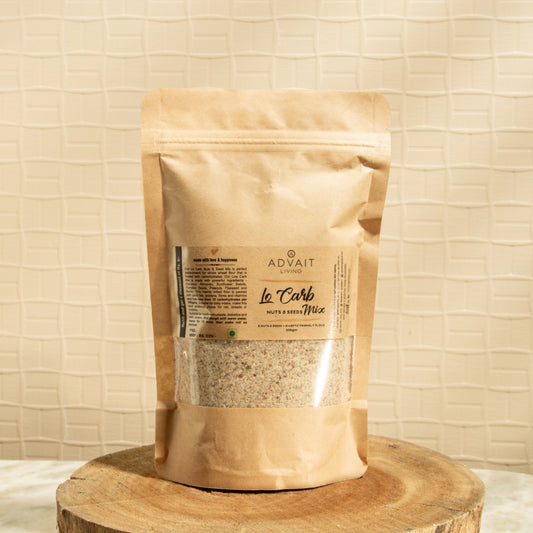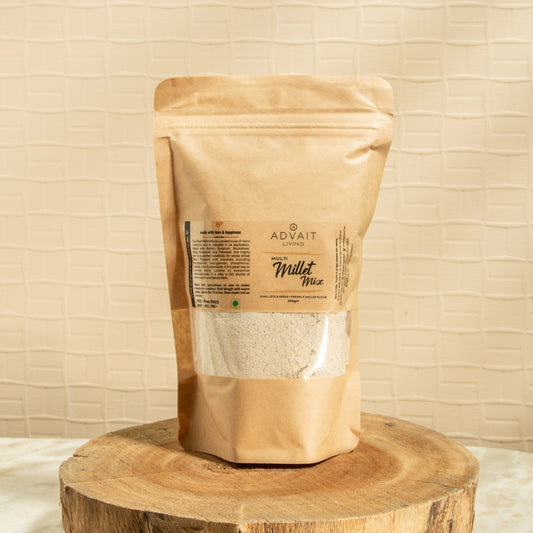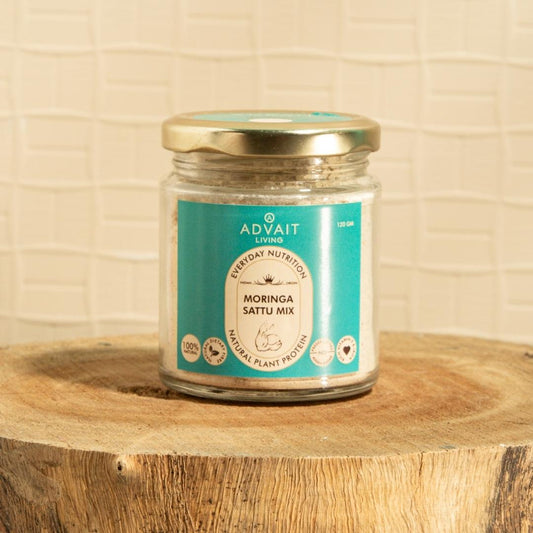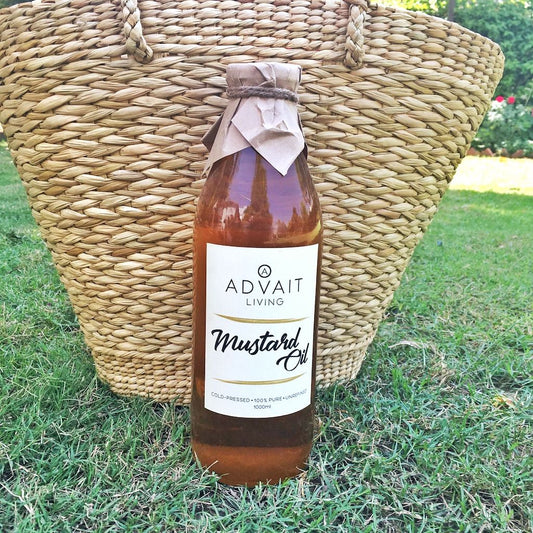Whole Wheat Flour has always been a staple in Indian homes and continues to be centre stage in the Indian diet. However, in recent years, multigrain atta has surged in popularity in India. This reflects a changing consumer preference for gluten-free options, higher nutritional content, increased versatility and enhanced flavour profile. It also points to a broader shift towards more holistic and health-conscious eating habits, driven by a desire for better nutrition and diverse, flavourful diets. Both flours can be used in a wide range of recipes, from bread to pastries to pancakes to pasta and continue to remain popular among home cooks and professional chefs alike.
But which flour (atta) should you choose for your kitchen, and what parameters should you evaluate while making that decision? Let's dive a little deeper into the world of flours.
What is Whole Wheat Atta?
Whole wheat atta is a flour that is produced by milling the entire wheat kernel, such as bran, germ, and endosperm. However, it should not be confused with refined wheat atta (which is an ultra-processed version of whole wheat atta). It is one of the most important cereal grains in the world and acts as the major source of carbohydrates in the form of starch. In India, whole wheat atta is largely used in the majority of households to make chapati, paratha, theplas, khichdi, poori, and many more. Wheat is well documented in classic Ayurvedic literature and was used in many pharmaceutical preparations to treat several diseases.
In Charaka Samhita (Ayurvedic treatise), wheat is described as sweet (Madhura), heavy (Guru), unctuous (Snigdha), and cooling (Śīta). It alleviates Vata and Pitta and is recommended for diseases like Diabetes, Rheumatic Arthritis, Tuberculosis, Sprue Syndrome, and Obesity. In Suśruta Samhita, the nourishing and strengthening properties of wheat are also mentioned. The history of wheat dates back to 10,000 BC, and even now, it is consumed widely around the world.
What is Multigrain Atta?
Multigrain Attas have been part of Indian households since ancient times. Traditionally, multigrain atta was produced by grinding various grains in small quantities for household purposes. People mixed wheat with seasonal grains all the time and created “missi roti”. Some of the most popular ‘missi roti’ in North India are made of wheat and besan. Other versions include wheat and bajra or wheat and green grams.
In more recent times, and unlike single-grain flours, new-age multigrain flours can be a combination of several grains such as wheat, barley, millet, oats, and others, resulting in a product rich in a variety of nutrients. For example, Advait Living’s Multigrain atta contains five whole grains, such as whole wheat, chickpea (black), green gram, corn, and flaxseeds. Multigrain atta is commonly used in Indian households to make various dishes like chapati, roti, and paratha. Over time, multigrain attas have evolved based on the consumer’s preference. It is now available in many forms, such as gluten-free, organic, and non-GMO grains with functional additions like flaxseeds, chia seeds, nuts, psyllium husks, etc.
Shift in Consumer Preferences
Multigrain flour is gaining popularity due to its numerous health benefits, diverse nutritional profile, and the increasing consumer demand for healthier food options. The rise of multigrain flour can be attributed to many reasons, but the three main reasons are:
A. Rise in Gluten Intolerance
Whole wheat atta contains a protein called gluten that is responsible for the strength and texture of the baked wheat products. Generally, hard wheat has naturally occurring gluten content around 12% to 14%. It is this gluten that acts as a binding agent to hold processed foods together and give them shape.
However, gluten intolerance is on the rise worldwide. Many individuals are unable to digest gluten and feel bloated, gassy or sick after eating it. In some people, gluten can even trigger a severe autoimmune response that damages the intestinal lining and causes celiac disease (CD).
Gliadin, a component of gluten, is responsible for provoking gluten intolerance in people. Gluten intolerance can also be attributed to changes in the wheat variety (with hybridised seeds), ultra-processing of wheat and overconsumption of refined foods. With rising gluten intolerance, health-conscious people are looking for alternative options to wheat and its processed versions.
Gluten-free multigrain products are one such solution and offer a large variety to cater to the specific needs of the customers. Furthermore, unlike whole wheat atta, multigrain attas can be customised to meet the consumer's needs. As such, there has been a rise in the demand for gluten-free or lower in gluten products, carb-free and lower in carb products.
B. Refined Wheat Atta
Refined wheat atta is processed industrially and is available in the market easily. Wheat is generally milled in large automated plants where it passes through several roller mills and the bran, endosperm and germ are separated and removed from the wheat kernel. This refined wheat flour is whiter and softer, making it more cosmetically desirable.
Furthermore, it is a generally held perception that most refined wheat flour is mixed with highly processed ‘maida’, which is considered to be unhealthy. Since FSSAI does not mandate wheat manufacturers to disclose ‘maida’ content, some manufacturers mix maida into wheat flour to reduce cost, increase the whiteness of roti and for other cosmetic benefits.
People perceive commercially available wheat to have little natural fibre, as modern atta factories typically process wheat without the bran, and typically the dietary fibre for refined wheat ranges from 7-13%, depending upon the processing techniques employed by the manufacturer. Modern wheat flour is far from the traditional wheat flour that used to be consumed by Indian households.
Hence, health-conscious individuals are moving away from the overconsumption of refined grains and are seeking varied diets that include a mix of grains for better health outcomes.
C. Higher Nutritional Content
While whole wheat flour is naturally rich in nutrients and provides several health benefits, it is considered to have a high carbohydrate content. Also, as a single-grain flour, it contains limited nutrients. Refined wheat flour contains even less dietary fibre and reduced nutrition (unless fortified).
Individuals seeking low-carbohydrate options, higher dietary fibre and increasing their access to a range of nutrients, are preferring to opt for multigrain atta. Multigrain attas with millets and other grains or seeds such as flaxseed can provide access to minerals such as iron, copper, manganese, and zinc and phytochemicals such as phenolic acids, flavonoids, and lignans.
Multigrain vs Whole Wheat Atta: Which one deserves to be in your kitchen?
Choosing between whole wheat atta and multigrain atta can be a little confusing as both whole wheat atta and multigrain atta provide several health benefits. Here are some factors to consider while choosing the best solution for your household.
1. Ingredients and Processing of the Atta
The first step to choosing an atta rests on checking the ingredients and processing (milling techniques) of the atta. A traditional variety of whole wheat atta (with non-hybridised seed) that is freshly milled on a stone-chakki is better when it comes to dietary fibre, nutritional content and flavour.
It also provides several health benefits. Evidence from studies has shown that traditional wheat grain may reduce the risk of cancer. Recent studies also proved that phytochemicals in wheat have a special role in preventing cancer. Other phytochemicals like lignans, flavonoids, and carotenoids have shown anticancer activities in both in vitro and in vivo studies.
Whole wheat atta can also aid in digestive health. Insoluble fibre present in the wheat grain streamlines bowel function by increasing stool weight, and soluble fibre decreases postprandial glycemia and reduces serum cholesterol.
Conversely, refined wheat flour is much lower in dietary fibre and has been stripped of many of its nutrients during the processing of the same. For example, Thiamine (Vitamin B1) is mainly found in the bran and germ of the wheat kernel, with up to 50% of it lost during milling. Thiamine is essential for the digestion of wheat, and a deficiency of thiamine may lead to poor carbohydrate tolerance and insulin resistance.
Multigrain atta is perceived to have higher dietary fibre as it is not subjected to such large industrialised processing. However, it is essential to note that not all multigrain attas may be the same. It is important to check all the ingredients of your multigrain atta. Evaluating the content of whole wheat vs refined wheat in your multigrain atta can also provide a better picture of its nutritional efficiency.
Further, checking the rest of the ingredients and processing techniques (the best method is slow-grinding stone-chakki) will inform you of the best atta to consider for your kitchen. In addition to all the benefits that whole wheat atta offers, multigrain atta provides access to more diverse nutrients and health advantages. It may also help reduce the risk of cardiovascular diseases, cholesterol, type 2 diabetes, high blood pressure, cancer, and obesity.
2. Taste and Texture
Whole wheat atta is characterised by a distinct nutty and earthy flavour, whereas the taste of multigrain atta is complex and has a distinct flavour with a variety of grains and seeds. The most congenial feature of whole wheat roti/bread is that it is soft, sweet and delicious. Indian households are very particular about the atta texture, taste, texture and softness of the roti, which determines the type of atta they bring into their household.
On the other hand, rotis made of multigrain atta vary a lot and totally depend upon the ingredients (different grains) used in the multigrain mix. Usually, the rotis/ bread are quite unique, might be chewy due to the seeds and grains in it and may need some getting used to the taste and texture of the roti.
3. Versatility
Both whole wheat and multigrain flour are usually highly versatile. Whole wheat atta can be used to bake breads, cookies, whole wheat pasta, and Indian flatbreads like chapati and paratha. It is also used as a thickening agent in soups, stews, and sauces for its high fibre content. Interestingly, multigrain atta can also be used in a variety of ways and is often used for baking multigrain bread, Indian flatbreads, multigrain cereals, granola mixes, and grain salads, among others.
4. Suitability for Dietary Needs
Whole wheat atta is best suited for individuals with no chronic diseases and who are free from gluten intolerance. People looking for an increased variety of nutrients can opt for multigrain atta and can customise specific grains to address particular health issues. For instance, people with celiac disease can opt for gluten-free grains.
5. Freshness of Atta
Whether you are planning to consume a whole wheat atta or a multigrain atta, it is best to choose an atta that is freshly milled. This is so because attas have a very short shelf life and can quickly lose their original flavours. Look for manufacturers who can offer you freshly milled attas that are stone-ground on traditional chekku, providing you with higher availability of nutrition.
Multigrain Attas to Try
Multigrain atta has a diverse nutritional composition and offers numerous health benefits upon consumption. Trying different types of multigrain atta enhances the meal experience and higher nutritive intake. Here are three different multigrain attas to add variety to your diet.
1. Multigrain Atta (Low Wheat Content)
Advait Living’s multigrain atta contains five whole grains -
- Whole wheat (40%),
- Black Chickpea (20%),
- Makka (corn) (20%),
- Whole Green Gram (15%),
- Flaxseeds (5%)
This proprietary mix of Advait Living’s multigrain atta consists of much lower whole wheat content at 40% (no refined wheat) as compared to commercially available multigrain attas, which consist primarily of wheat (that ranges anywhere between 60-80%). In commercial multigrains, other grains range at just 20-30% approximately. However, with Advait Living’s multigrain atta, you can access 60% of other grains, making it truly exciting and unique.
Moreover, it is loaded with natural dietary fibre as the entire wheat kernel (including bran, germ, and endosperm) is used for all the grains included in making this multigrain flour. It also boasts several micro and macronutrients, helps in reducing the risks of heart disease, diabetes, and inflammation, and is good for digestion.
Most importantly, this fresh mix is produced in small batches without any preservatives or additives to ensure top quality. It is best to store this flour in the refrigerator to increase its shelf life for up to 6 months.
Advait Living’s multigrain atta is best used to make homemade rotis. Since it is high in fibre, the roti may be darker than wheat rotis and need to be served hot. Rotis kept in the casserole will become hard and chewy. To make softer roti’s you have the option of adding more regular atta to your dough. Just take a 50:50 ratio of multigrain mix with normal wheat atta (from your kitchen) and make your rotis.
2. Multi Millet Mix Atta (Gluten-Free)
Advait Living’s Multi Millet Mix Atta is a perfect alternative for whole wheat atta that contains gluten. This Multi Millet Mix Atta contains
- Sorghum (30%)
- Barley (30%)
- Buckwheat (10%)
- Ragi (10%)
- Amaranth (10%)
- Flaxseed (10%)
This proprietary mix of multigrains is 100% gluten-free and only contains traditionally grown millets. It is loaded with natural dietary fibre as the entire millet kernel (including bran, germ, and endosperm) is milled on a slow stone chakki. No wheat is added.
This millet mix is enriched with amino acids, dietary fibres, and minerals like magnesium, manganese, phosphorus, copper, zinc, and potassium. Adding this multi-millet mix to your diet ensures healthy digestion and bowel movement, relieves fatigue, and acts as a great source of energy. Most importantly, this fresh mix is produced in small batches to ensure top quality. Preservatives like bromate, L-cysteine, calcium peroxide, and sodium stearoyl lactylate are not used in this mix. Refrigerate the mix to increase its shelf life naturally for up to 6 months.
This multi-millet mix is a great atta to start with if you are considering introducing millets into your diet. This millet atta is excellent for making homemade rotis, sourdoughs, breads and cookies. Since it is high in fibre, the roti may be dark and need to be served hot. Rotis kept in the casserole will become hard and chewy, so prepare fresh and serve it immediately. Adding a dollop of A2 Cow Ghee makes it a complete meal and adds a good layer of healthy fats to increase its digestive properties.
3. Lo Carb Atta (Low-Carbohydrate-High-Fat)
Advait Living’s Lo Carb Nuts & Seeds Mix is another excellent replacement for whole wheat atta, especially for those who are considering reducing carbohydrates in their diets. It contains
- Coconut flour
- Flaxseed
- Amaranth
- Peanuts
- Sunflower Seeds
- Almonds
- Pumpkin Seeds
- Barley
This proprietary mix of multigrains is 100% gluten-free and contains less than 10 carbohydrates per 100 g of atta.
Loaded with coconut, almonds, sunflower seeds, pumpkin seeds, peanuts, flaxseeds, and barley, Lo carb atta offers high fats and low carbohydrates with good amounts of protein that regulate the insulin in the body. This atta is ideal for keto dieters, diabetic patients, and health enthusiasts in general.
Our Lo carb atta is freshly milled only after you place your order and has a shelf life of 1 month. It also lacks preservatives and additives, such as bromate, glycerides, ascorbic acid, and azodicarbonamide (ADA), keeping it more healthy.
To extend the shelf life, refrigerate this atta and enjoy it for up to 6 months. Rotis made from Lo-carb atta are grainy, chewy and may require getting accustomed to their unique flavour and texture. To make rotis, make the dough with hot water, add a tsp of oil and leave for 15-30 mins before rolling the rotis.
You can use it to make rotis, breads, sourdoughs and cookies.
Conclusion
In conclusion, both whole wheat atta and multigrain atta provide several health benefits. Both attas include various nutrients, such as dietary fibres, proteins, carbohydrates, fatty acids, vitamins & minerals, improving digestive health, and blood sugar levels and alleviating the risk of cardiovascular disease and obesity.
Multigrain Vs Whole Wheat atta - which one should you consume? The answer lies in balance. If you have no medical reason, then it's great to have both in your kitchen as they offer variety and access to additional nutrition.
However, for people with medical reasons or people looking for a specific outcome such as weight loss or gluten-free meals, experimenting with multigrain attas can be more promising. Multigrain atta is best when the goal is to go gluten-free, or add variety or boost nutritional intake. Therefore, the best choice depends on individual lifestyle and health goals.
Frequently Asked Questions
1. Is multigrain atta better than normal atta?
Multigrain atta is made from a blend of different grains such as wheat, barley, oats, millet, and others, whereas normal atta is typically made from only wheat. With its diverse composition, it offers superior nutritional benefits compared to normal atta. It supports better gut health, helps in maintaining healthy blood pressure and blood sugar levels, and contributes to cardiac health. Also, it helps in weight management and supports bone health.
2. What is the difference between single grain atta and multigrain atta?
As the name suggests, single grain atta is made from grinding one type of grain, typically wheat. On the other hand, multigrain atta is made from grinding various grains and seeds to enhance its nutrient profile and health benefits.
3. Can we eat multigrain roti daily?
Yes, you can eat multigrain roti every day. It is a good source of essential macro and micronutrients. It also prevents the risk of numerous diseases and improves your overall health. It helps keep our regular diet balanced.
4. Does multigrain atta have maida?
No, multigrain atta usually doesn’t contain maida. Maida is basically refined wheat flour. Any good quality stone-ground multigrain atta will not contain maida. However, if you are buying your multigrain atta from a commercial or mass-producing brand, it is important to check the ingredient lists and avoid any multigrain atta or mix with maida or other refined flour.












